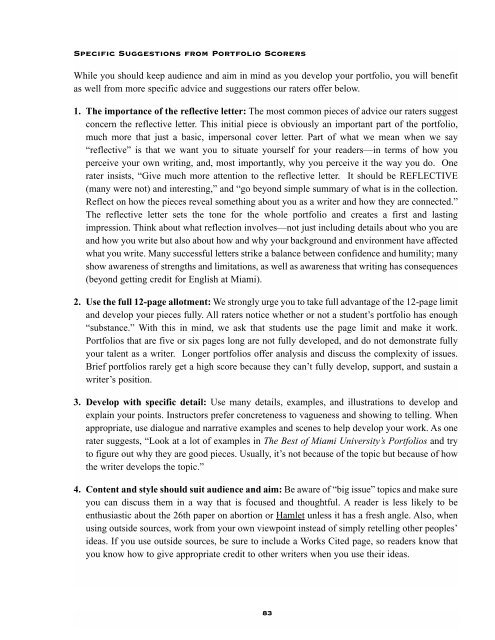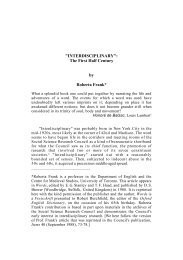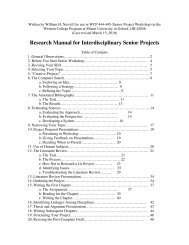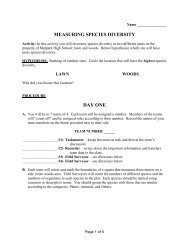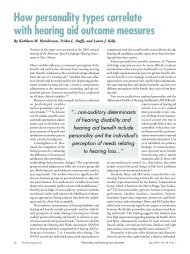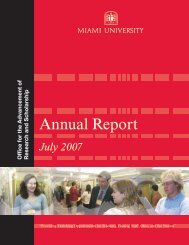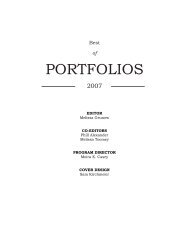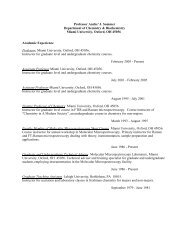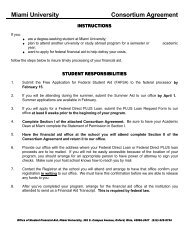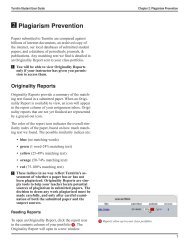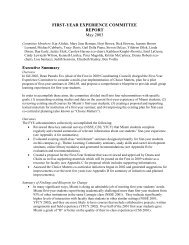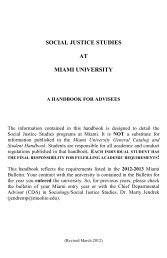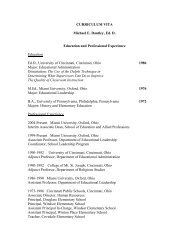Best of Miami Portfolios 2001 - Units.muohio.edu
Best of Miami Portfolios 2001 - Units.muohio.edu
Best of Miami Portfolios 2001 - Units.muohio.edu
You also want an ePaper? Increase the reach of your titles
YUMPU automatically turns print PDFs into web optimized ePapers that Google loves.
Specific Suggestions from Portfolio Scorers<br />
While you should keep audience and aim in mind as you develop your portfolio, you will benefit<br />
as well from more specific advice and suggestions our raters <strong>of</strong>fer below.<br />
1. The importance <strong>of</strong> the reflective letter: The most common pieces <strong>of</strong> advice our raters suggest<br />
concern the reflective letter. This initial piece is obviously an important part <strong>of</strong> the portfolio,<br />
much more that just a basic, impersonal cover letter. Part <strong>of</strong> what we mean when we say<br />
“reflective” is that we want you to situate yourself for your readers—in terms <strong>of</strong> how you<br />
perceive your own writing, and, most importantly, why you perceive it the way you do. One<br />
rater insists, “Give much more attention to the reflective letter. It should be REFLECTIVE<br />
(many were not) and interesting,” and “go beyond simple summary <strong>of</strong> what is in the collection.<br />
Reflect on how the pieces reveal something about you as a writer and how they are connected.”<br />
The reflective letter sets the tone for the whole portfolio and creates a first and lasting<br />
impression. Think about what reflection involves—not just including details about who you are<br />
and how you write but also about how and why your background and environment have affected<br />
what you write. Many successful letters strike a balance between confidence and humility; many<br />
show awareness <strong>of</strong> strengths and limitations, as well as awareness that writing has consequences<br />
(beyond getting credit for English at <strong>Miami</strong>).<br />
2. Use the full 12-page allotment: We strongly urge you to take full advantage <strong>of</strong> the 12-page limit<br />
and develop your pieces fully. All raters notice whether or not a student’s portfolio has enough<br />
“substance.” With this in mind, we ask that students use the page limit and make it work.<br />
<strong>Portfolios</strong> that are five or six pages long are not fully developed, and do not demonstrate fully<br />
your talent as a writer. Longer portfolios <strong>of</strong>fer analysis and discuss the complexity <strong>of</strong> issues.<br />
Brief portfolios rarely get a high score because they can’t fully develop, support, and sustain a<br />
writer’s position.<br />
3. Develop with specific detail: Use many details, examples, and illustrations to develop and<br />
explain your points. Instructors prefer concreteness to vagueness and showing to telling. When<br />
appropriate, use dialogue and narrative examples and scenes to help develop your work. As one<br />
rater suggests, “Look at a lot <strong>of</strong> examples in The <strong>Best</strong> <strong>of</strong> <strong>Miami</strong> University’s <strong>Portfolios</strong> and try<br />
to figure out why they are good pieces. Usually, it’s not because <strong>of</strong> the topic but because <strong>of</strong> how<br />
the writer develops the topic.”<br />
4. Content and style should suit audience and aim: Be aware <strong>of</strong> “big issue” topics and make sure<br />
you can discuss them in a way that is focused and thoughtful. A reader is less likely to be<br />
enthusiastic about the 26th paper on abortion or Hamlet unless it has a fresh angle. Also, when<br />
using outside sources, work from your own viewpoint instead <strong>of</strong> simply retelling other peoples’<br />
ideas. If you use outside sources, be sure to include a Works Cited page, so readers know that<br />
you know how to give appropriate credit to other writers when you use their ideas.<br />
83


